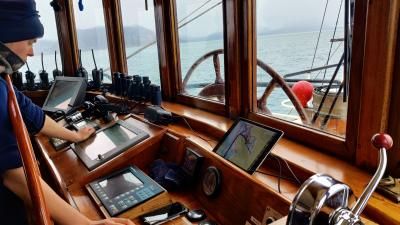The Arctic is attracting growing global interest – not only because of its fragile environment, but also due to expanding commercial shipping and offshore activities. As sea ice retreats and new economic opportunities emerge, more vessels are entering these waters. But alongside the geopolitical and ecological stakes, another important question is often overlooked: what does all this mean for the people who work at sea?
That question is at the heart of my PhD research in social anthropology at the University of Bergen. In this blog I introduce the project, explain why I’m doing it, and outline what I hope to learn about technology, risk, and the practice of seamanship in the changing Arctic.
Why study technology and risk in the Arctic?
The Arctic is not just cold and remote – it’s also complex, risky, and highly regulated. As maritime activity increases, shipping companies are investing in new vessels, digital tools, and training programs aimed at managing these risks. Technologies like integrated bridge systems, electronic chart displays, and virtual reality (VR) simulators are becoming standard. These tools are designed to make operations safer and more efficient, especially under the International Maritime Organization’s Polar Code.
But technologies do not operate in a vacuum. They are always embedded in social settings. They are interpreted, negotiated, and sometimes resisted by the people who use them. Understanding how these tools interact with human judgment, embodied knowledge, and practical decision-making is key to understanding how risk is actually managed at sea.
Seamanship: the craft behind the controls
One of the core concerns in my research is the changing nature of seamanship. Seamanship is not just about technical skills or following procedures – it involves a deep, often intuitive understanding of the sea, the ship, and the unpredictable conditions of polar navigation. It’s about developing a feel for the vessel, reading subtle signs in weather and movement, and making decisions that draw on years of experience.
New technologies can both support and undermine these forms of knowledge. For example, automation might reduce workload but also deskill certain aspects of navigation. Simulators can train officers to follow standard procedures, but might struggle to capture the tacit, embodied dimensions of real-world seamanship in Arctic conditions.
By looking at how seafarers adapt to – or push back against – new tools, I aim to shed light on how seamanship is evolving, and what might be lost or gained in the process.
What I’m doing and why
I’ve spent time on board Arctic shuttle tankers and cruise ships, attended VR-based Polar Code training courses, and followed inspectors from the Norwegian Maritime Authority as they evaluate vessels operating in the north. I conducted interviews with seafarers and maritime stakeholders and engaged in participant observation, taking part in and observing daily routines to better understand practices from within. Through this fieldwork, I study how risk, responsibility, and authority are negotiated in practice – not just through manuals or regulations, but through everyday routines, conversations, and the unspoken cues that shape how people read’ a situation.
I’m especially interested in what happens at the intersection between human and technological responsibility: when a simulator glitches, when an alarm system is misread, or when the chain of command becomes blurred. These moments offer valuable insight into the underlying assumptions of the technologies in use – and the real skill it takes to navigate them.
Bigger questions and wider relevance
Although my research is focused on maritime work in the Arctic, the questions it raises are much broader. How do professionals maintain trust in their judgment when working with increasingly automated systems? What forms of knowledge are recognised – and which are made invisible – by new regulatory regimes? And what happens to traditional skills like seamanship when they’re reframed through the lens of training modules and efficiency metrics?
These questions matter not only for seafarers but also for policymakers, educators, and designers of new technologies. As we move toward a future of greener, more digital maritime operations, we need to think critically about what kinds of knowledge and experience are valued – and what we risk overlooking.
If you would like to find out more about this project, you can get in touch at daniel.paulsen@uib.no.




